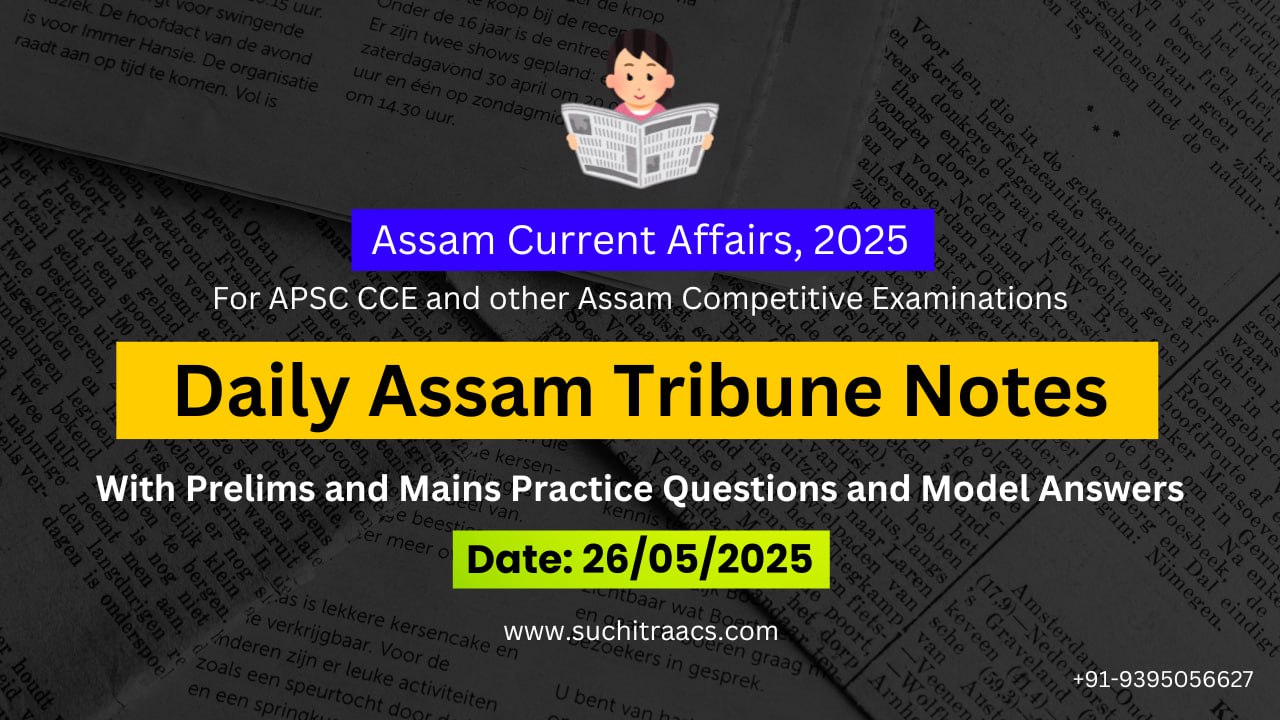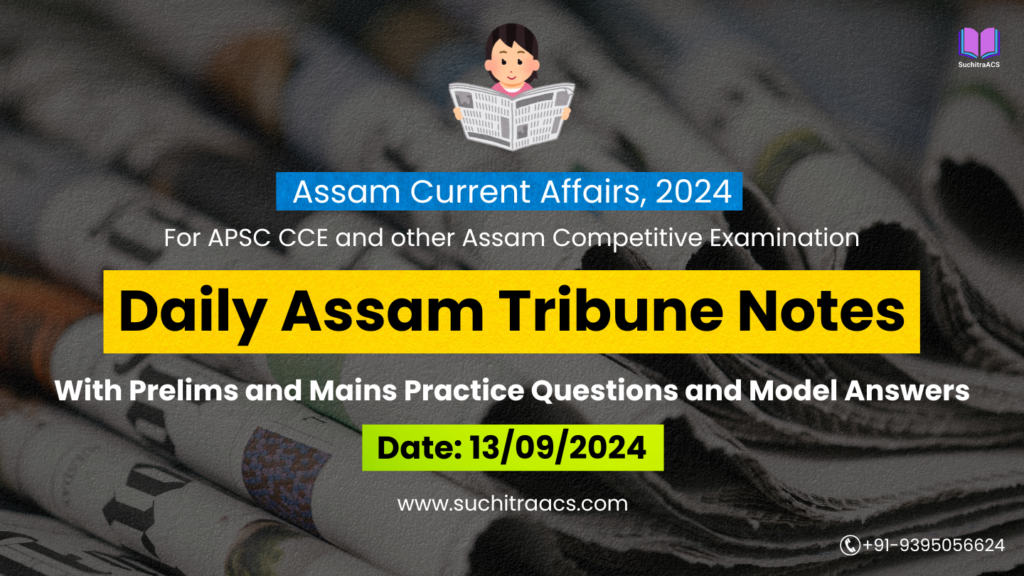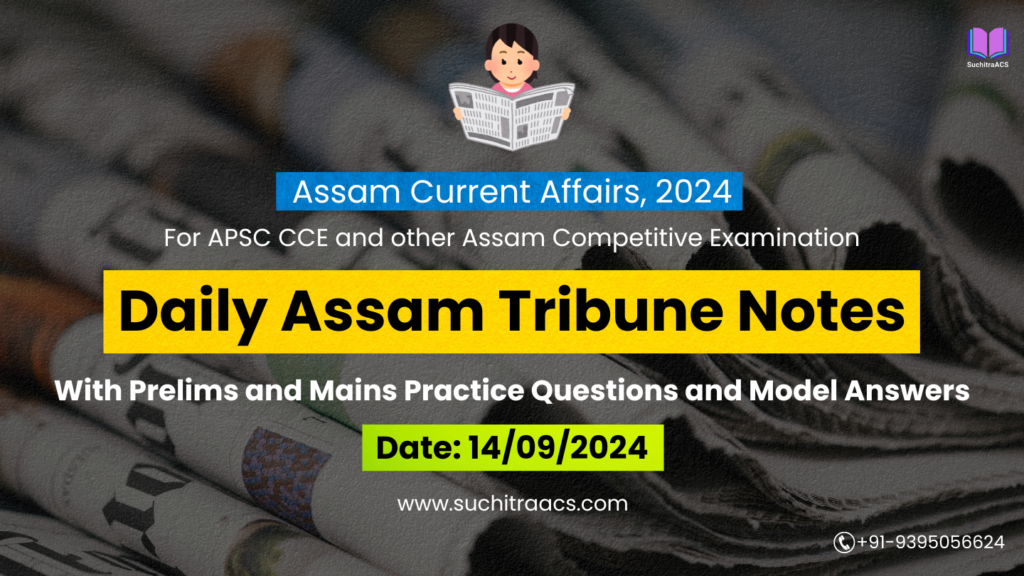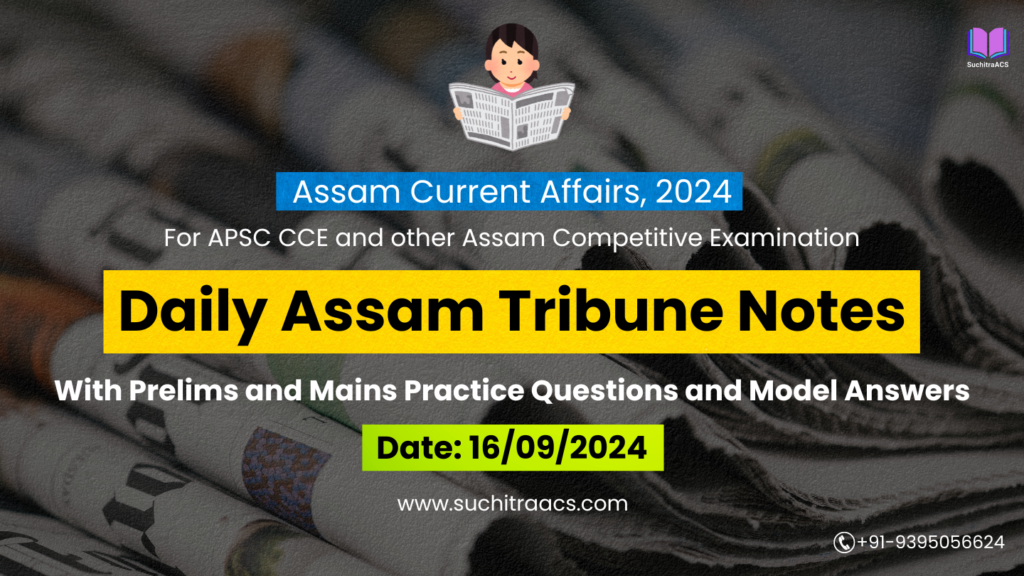APSC Current Affairs: Assam Tribune Notes with MCQs and Answer Writing (26/05/2025)
For APSC CCE and other Assam Competitive examinations aspirants, staying updated with current affairs is vital. This blog covers most important topics from the Assam Tribune today (26-05-2025). These issues are key for both APSC Prelims and Mains preparation, offering insights into the APSC CCE Syllabus.
✨ Current Affairs Crash Course for the APSC Prelims 2025

🟢 Topic: India Partners with WHO to Mainstream AYUSH Globally
📘 GS Paper 2: Health | International Relations | Government Policies
📘 GS Paper 3: Science & Technology | Traditional Knowledge Systems
📘 APSC GS Paper 4 & 5: Health Infrastructure | Cultural Heritage | Assam’s Traditional Healing Practices
🔹 Introduction
India has entered into a landmark agreement with the World Health Organization (WHO) to develop a Traditional Medicine module under the International Classification of Health Interventions (ICHI). This step aims to give global recognition to India’s indigenous medical systems like Ayurveda, Siddha, Unani, Yoga, and related therapies under a standardized global framework.
🔑 Key Highlights
| Feature | Details |
| Signed Between | Ministry of AYUSH & WHO |
| Purpose | Integration of AYUSH therapies into WHO’s ICHI framework |
| Systems Covered | Ayurveda, Yoga, Siddha, Unani (Panchakarma, yoga therapy, regimens) |
| Alignment With | WHO’s ICD-11 (disease classification system) |
| Major Benefits | Transparent billing, fair pricing, health insurance inclusion, global visibility |
| Significance | Evidence-based recognition and mainstreaming of AYUSH globally |
⚙️ Prelims Pointers
ICHI (International Classification of Health Interventions): WHO’s global framework that catalogs medical interventions, now to include traditional therapies.
ICD-11: WHO’s disease classification system – India already contributes to it.
Panchakarma: Detoxification treatment in Ayurveda.
Ministry of AYUSH: Established in 2014 to promote indigenous systems of medicine.
WHO Global Centre for Traditional Medicine: Launched in Jamnagar, Gujarat in 2022 – first of its kind.
📝 Mains Pointers
A. Significance of the Agreement
Standardized Global Recognition: Indian traditional medicine will be classified in WHO’s global health system—validating it on a scientific and policy platform.
Boost to Medical Diplomacy: Enhances India’s role in Global South health partnerships, especially in Africa, Latin America, and ASEAN.
Health Insurance & Clinical Integration: AYUSH treatments can now be included in mainstream insurance systems and EMR (electronic medical records).
Boost to AYUSH Exports: Harmonized coding helps promote AYUSH wellness products and services globally.
Scientific Validation: Integration under ICHI will be evidence-backed, increasing academic research and global trials.
B. Challenges
| Area | Challenge |
| Scientific Rigor | Lack of adequate large-scale clinical trials for traditional medicine |
| Skepticism from Allopathy | Resistance from modern medicine practitioners globally |
| Commercial Misuse | Risk of unverified products being exported under AYUSH label |
| Lack of Regulation | Disparity in global standards for AYUSH medicine use and marketing |
C. Implications for Assam and Northeast
Revival of Indigenous Knowledge: Encourages documentation of tribal and local healing practices from NE (e.g., herbs used by Bodos, Mishings, Karbis).
Export Potential: Assam’s medicinal plant biodiversity (e.g., Bhut Jolokia, turmeric) can be standardized and exported.
AYUSH Infrastructure: Boost for AYUSH colleges, hospitals, and wellness tourism in NE.
Skilling & Employment: Training of youth in AYUSH therapies can create a new rural health workforce.
D. Way Forward
Digital Integration: Link AYUSH interventions with India’s Ayushman Bharat Digital Mission (ABDM).
Research Incentives: Encourage ICMR, CSIR, and AYUSH Research Councils to fund collaborative trials.
Global Awareness: Conduct roadshows and expos in Europe, Africa, ASEAN to showcase India’s wellness tradition.
Quality Control: Strengthen the Pharmacopoeia Commission for Indian Medicine to ensure safety and standardization.
State-Level Missions: Assam and other NE states can create regional AYUSH innovation hubs under State Medicinal Plant Boards.
📚 Reports & Policies to Cite
National AYUSH Mission (2021–26)
WHO Traditional Medicine Strategy 2014–2023
Global Centre for Traditional Medicine (Jamnagar)
Draft ICHI Guidelines by WHO (2024)
Medicinal Plants Board Guidelines (Assam)
🧩 Conclusion
India-WHO collaboration to mainstream AYUSH in ICHI is not just a global coding update, but a civilizational shift in healthcare diplomacy. It redefines India’s soft power, promotes affordable and holistic care, and creates global legitimacy for its ancient wisdom in modern times.
🟢 Topic: CBI Conducts Raids in Assam in Child Pornography Crackdown under Operation ‘Megh Chakra’
📘 GS Paper 2: Governance | Polity | Cyber Laws
📘 GS Paper 3: Internal Security | Cybersecurity | Crime Prevention
📘 APSC GS Paper 5: Law and Order in Assam | Technology and Society
🔹 Introduction
As part of Operation ‘Megh Chakra’, the Central Bureau of Investigation (CBI) conducted simultaneous searches in Assam and other states in a major crackdown on online child sexual abuse material (CSAM). This operation, based on inputs from Interpol and cloud data sources, marks India’s renewed commitment to child protection, digital forensics, and cyber law enforcement.
🔑 Key Highlights
| Element | Details |
| Operation Name | Megh Chakra |
| Agency Involved | Central Bureau of Investigation (CBI) |
| Trigger Source | Interpol & cloud-based CSAM detection |
| States Raided | Assam, Delhi, Maharashtra, Tamil Nadu, West Bengal, etc. |
| Offences Targeted | Upload, possession, circulation of child sexual abuse content |
| Legal Framework Used | IT Act 2000 (Amended), POCSO Act, IPC Sections on obscenity and trafficking |
⚙️ Prelims Pointers
POCSO Act, 2012: Protection of Children from Sexual Offences Act – provides child-friendly reporting, trial, and stringent punishment.
Section 67B of IT Act: Criminalizes transmission or browsing of child sexual content online.
Megh Chakra: Named to symbolize cloud-based (Megh) crime tracking by CBI.
Interpol: Global police coordination agency; shares cross-border cybercrime intel.
CERT-In: National nodal agency for cybersecurity incidents – not involved in arrests but supports digital tracking.
📝 Mains Pointers
A. Significance of Operation Megh Chakra
Technology-Driven Policing: Uses cloud traceability and metadata to track content originators.
Inter-Agency Coordination: Collaboration among CBI, State Police, Interpol, and forensic labs.
Precedent for Accountability: Highlights zero-tolerance approach to child pornography in India.
Focus on Assam: Raids in Assam show the geographic spread of cybercrime, including in semi-urban and rural areas.
Digital Evidence Handling: Seizure of hard drives, mobile phones, and cloud storage linked to CSAM circulation.
B. Challenges in Tackling Cyber Abuse Crimes
| Issue | Explanation |
| Dark Web Proliferation | Many CSAM networks operate through encrypted platforms |
| Low Reporting Rates | Stigma and lack of awareness among parents and children |
| Forensic Delays | Limited number of certified cyber labs in India |
| Jurisdictional Complexity | Offenders often operate across borders and IP masking makes tracking difficult |
| Legal Loopholes | Need for stricter implementation of intermediary guidelines for platforms like Telegram, WhatsApp |
C. Policy and Legal Framework Enhancements
IT Rules (Intermediary Guidelines) 2021: Mandate platforms to remove CSAM within 24 hours of reporting
Draft Digital India Bill (Upcoming): Expected to replace the IT Act and include stricter penalties for cyber harms
NCPCR Guidelines: For online child safety and response protocols in schools
CBI Cyber Crime Coordination Centre: Centralised database and AI-based analysis for patterns in CSAM content
Ministry of Women & Child Development Schemes: Like POCSO e-box, Childline, and National Cyber Crime Reporting Portal
D. Way Forward
Digital Literacy for Parents & Students: Especially in NE and rural belts where awareness is low
Cloud-Based AI Monitoring Tools: Pre-emptively flag CSAM circulation before viral spread
More Cyber Forensics Labs: State-level infrastructure in Assam and NE needed
Fast-Track Courts for Cyber POCSO: To ensure swift and deterrent punishment
Public–Private Collaboration: Tech firms must be mandated to report child abuse content proactively
📚 Relevant Reports & Frameworks
NCRB Crime in India Report (2023–24) – Shows rise in cyber offences against children
Interpol Cybercrime Strategy 2022–2025
UNICEF Child Online Protection Guidelines
Justice Verma Committee (2013) – Emphasized the role of tech in child abuse prevention
Supreme Court Directions in Prajwala Case – Mandated removal of CSAM from digital platforms
🧩 Conclusion
Operation Megh Chakra is a technological and legal milestone in India’s battle against online child exploitation. For Assam and the Northeast, it underlines the urgency of investing in cyber forensics, community awareness, and preventive law enforcement to protect the most vulnerable in the digital age.
🟢 Topic: India’s Election Commission Gears Up for Counting of Votes with Enhanced Security & AI Monitoring
📘 GS Paper 2: Polity | Election Commission | Electoral Reforms
📘 GS Paper 3: Science & Technology | Cybersecurity | AI in Governance
📘 APSC GS Paper 5: Governance | Role of Institutions | Election Management
🔹 Introduction
As the country prepares for the vote counting of the 18th Lok Sabha elections, the Election Commission of India (ECI) has implemented enhanced security arrangements, including the use of AI-powered surveillance, multi-layered verification protocols, and real-time result transmission. The initiative showcases India’s move toward tech-enabled electoral governance.
🔑 Key Highlights
| Feature | Details |
| Authority | Election Commission of India (ECI) |
| Occasion | Vote counting for Lok Sabha Elections 2024–25 |
| Tech Deployment | AI-based CCTV analytics, GPS-tracked EVMs, real-time dashboards |
| Security Layering | CAPF deployment, 24×7 CCTVs in strongrooms, randomized counting staff |
| Training Protocols | All officers trained under ECI’s Counting Guidelines 2023 |
| Transparency Initiatives | Voter helplines, public web portals, and booth-wise tracking |
⚙️ Prelims Pointers
ECI: A constitutional body under Article 324; responsible for conducting free and fair elections.
Form 17C: The statutory form used for recording votes cast in each EVM – critical to counting.
VVPAT (Voter Verified Paper Audit Trail): Used alongside EVMs; 5 random VVPATs are tallied with EVM results in each Assembly segment.
CAPF (Central Armed Police Forces): Deployed to maintain law and order during vote counting.
Counting Observer: A senior IAS officer appointed by ECI to ensure fairness and rule compliance at each center.
📝 Mains Pointers
A. Significance of Tech-Enabled Vote Counting
Ensures Transparency: Live CCTV feeds and VVPAT verification reassure voters and stakeholders.
Prevents Tampering: EVMs and VVPATs under constant surveillance; tamper-proof strongrooms monitored via AI.
Fast & Reliable Updates: Real-time dashboards reduce misinformation and speculation.
Improves Accountability: GPS tracking of EVMs prevents unauthorized movement or replacement.
Reduces Manual Error: AI helps flag unusual behavior or manual discrepancies during counting.
B. Challenges in Electoral Infrastructure
| Challenge | Impact |
| Cybersecurity Risks | Vulnerability to misinformation campaigns or DDoS attacks on ECI servers |
| Digital Divide | Low digital literacy may hamper transparency in rural areas |
| Logistical Complexity | Coordinating across 700+ districts, 10+ lakh polling stations |
| Trust Deficit | Persistent narratives around EVM manipulation in some quarters |
| Legal Delays | Post-poll litigations and recount demands clog judicial forums |
C. Reforms and Innovations by ECI
cVIGIL App: Citizen-based reporting of electoral violations
SUVIDHA Portal: For online nominations, expenditure tracking
Remote Voting Machine (RVM): Still in trial stage for migrant voter participation
AI-Powered Booth Profiling: For deploying security and personnel based on historical data
Training Modules via iGOT Platform: E-learning for counting staff and officers
D. Way Forward
Universal VVPAT Reconciliation: Not just random 5 booths—consider 100% reconciliation for high-stakes seats
Digital Literacy Drives: Especially in NE and tribal areas to explain vote counting tech
Blockchain-Based Result Transmission: For higher trust and tamper-proof reporting
Independent Auditing: External watchdogs to certify process integrity
Voter Awareness Campaigns: Targeted efforts to build trust in AI and digital counting tools
📚 Relevant Frameworks & Reports
Model Code of Conduct (MCC)
ECI Counting Guidelines 2023
SCEC-UNDP Electoral Integrity Index
Second ARC Report on Electoral Reforms
Law Commission Report (255th) on Electoral Reforms
🧩 Conclusion
The Election Commission’s use of AI and real-time monitoring in vote counting reflects India’s effort to build digital trust in democratic processes. As technology becomes more integral, a people-centric and transparent electoral system remains the bedrock of India’s constitutional democracy.
🟢 Topic: Cyclone Remal Likely to Hit Eastern India and Bangladesh Coasts
📘 GS Paper 1: Geography – Climatology | Natural Disasters
📘 GS Paper 3: Disaster Management | Environment | Climate Change
📘 APSC GS Paper 5: Assam-Specific Disaster Preparedness | Regional Climate Vulnerability
🔹 Introduction
Cyclone Remal, formed over the Bay of Bengal, is expected to make landfall between the West Bengal-Bangladesh coast, with associated impacts in Assam, Meghalaya, Tripura, and Arunachal Pradesh. The Indian Meteorological Department (IMD) has issued orange alerts in several Northeast states, with the National Disaster Response Force (NDRF) already deployed.
🔑 Key Highlights
| Element | Details |
| Cyclone Name | Remal (named by Oman; means “sand” in Arabic) |
| Category | Likely to intensify into a Severe Cyclonic Storm (SCS) |
| Expected Landfall | May 26 night or May 27 morning |
| Affected States (India) | West Bengal, Odisha, Assam, Meghalaya, Tripura, Arunachal Pradesh |
| Impact Forecast | Winds up to 110 km/h, heavy to very heavy rainfall, flash floods, landslides |
| Agencies Active | IMD, NDRF, SDRF, State Governments, Indian Coast Guard |
⚙️ Prelims Pointers
IMD Cyclone Alerts:
Yellow – Watch
Orange – Be Prepared
Red – Take Action
Cyclone Naming: Rotationally by 13 countries in WMO/ESCAP panel; Remal was suggested by Oman.
Bay of Bengal Cyclones: More intense than Arabian Sea cyclones due to warm sea surface temperatures and geography.
NDRF: Premier disaster response agency under MHA; currently active in 5 NE states.
NDMA: Provides national cyclone preparedness guidelines; Assam has its own SOPs under ASDMA.
📝 Mains Pointers
A. Why Northeast is Vulnerable to Cyclones
Spillover Effect: Cyclones making landfall in coastal Bengal and Bangladesh move inland through Assam-Meghalaya corridor.
Riverine Geography: Brahmaputra and Barak basins prone to flooding and sedimentation post-cyclone rains.
Hilly Terrain: In Meghalaya and Arunachal, heavy rainfall leads to landslides and road blockages.
Poor Infrastructure: Inadequate drainage and fragile housing structures, especially in tea garden areas.
Lack of Preparedness in Remote Areas: Many riverine islands (chars) and tribal belts lack early warning access.
B. Government Response
| Action | Details |
| Evacuation Plans | SDRF teams active in Karimganj, Dima Hasao, Cachar |
| School Closures | Declared in coastal and flood-prone districts |
| Crop Loss Alerts | Issued to tea estates and farmers in Barak Valley |
| IMD & ASDMA Coordination | Real-time rainfall and wind tracking dashboard activated |
| NDRF Pre-positioning | Teams sent to Hojai, Goalpara, and West Tripura |
C. Lessons from Past Cyclones (e.g., Amphan, Yaas, Sitrang)
Early Warning Saves Lives: Mobile alerts and cyclone shelters in Bengal showed impact
Char Areas Neglect: Assam’s river islands still lack cyclone-resilient shelters
Tea Sector Damage: Rain and wind damage to leaf yield and infrastructure observed
Post-Disaster Recovery: Compensation and relief often delayed in hilly, remote zones
D. Way Forward for Assam and NE
Cyclone Shelters in Interior NE: Build in char, tribal, and hill areas using central schemes
Integrated Flood-Cyclone Risk Mapping: Overlap cyclone paths with annual flood zones
Mobile Early Warning Units: Battery-powered loudspeaker vans and community radios
Community First Responder Training: Local SHGs and youth groups as primary support units
Crop Insurance & Post-Disaster Livelihood Schemes: Special packages for STGs and river farmers
📚 Relevant Frameworks & Reports
State Disaster Management Plan (SDMP), Assam
Sendai Framework for Disaster Risk Reduction (2015–2030)
India Meteorological Department Annual Cyclone Review
World Bank’s Resilient Infrastructure Report (2022)
UNDP Climate Resilience Toolkit for NE
🧩 Conclusion
Cyclone Remal is another climate stress test for the Northeast’s fragile ecosystems and communities. It highlights the urgent need for climate-resilient infrastructure, decentralized disaster response systems, and socioeconomic safety nets to protect Assam and its neighbours from recurrent extreme weather events.
APSC Prelims Practice Questions
✅ Topic 1: India–WHO Agreement on AYUSH Integration
Q1. The recent India–WHO agreement aims to integrate traditional Indian medicine systems into which of the following global frameworks?
A. WHO’s ICD-11 only
B. International Classification of Health Interventions (ICHI)
C. Global Burden of Disease (GBD) Database
D. Sustainable Development Goals (SDGs) Monitoring Dashboard
✅ Answer: B
Explanation:
- The agreement seeks to include AYUSH therapies under the ICHI—a WHO framework classifying global health interventions.
- ICD-11 focuses on disease classification, while ICHI is specific to procedures and treatments.
Q2. Which of the following institutions is located in India and plays a central role in global traditional medicine initiatives?
A. Global Centre for One Health
B. WHO Global Centre for Traditional Medicine
C. International Institute for Ayurveda Research
D. Indian Institute of Global Health Standards
✅ Answer: B
Explanation:
- The WHO Global Centre for Traditional Medicine was inaugurated in Jamnagar, Gujarat in 2022, the first such initiative by WHO worldwide.
✅ Topic 2: CBI’s Operation Megh Chakra – Cybercrime Crackdown
Q3. Under which legal provision is the possession and circulation of child sexual abuse material (CSAM) criminalized in India?
A. Section 69A of the IT Act
B. Section 66F of the IT Act
C. Section 67B of the IT Act
D. Section 65 of the Copyright Act
✅ Answer: C
Explanation:
- Section 67B of the IT Act, 2000 specifically penalizes publishing, browsing, or transmitting material depicting children in sexually explicit acts.
Q4. Which of the following bodies was involved in providing intelligence inputs that led to the CBI’s Operation Megh Chakra?
A. UNESCO
B. CERT-In
C. Interpol
D. Europol
✅ Answer: C
Explanation:
- Interpol, the global police cooperation agency, provided cloud-based intelligence on child pornography networks, triggering the operation.
✅ Topic 3: Use of AI and Tech in Lok Sabha Vote Counting
Q5. Which of the following digital tools is directly used by the Election Commission of India to monitor and report electoral violations by citizens?
A. eCourts App
B. cVIGIL App
C. EVM Tracker
D. Samadhan Portal
✅ Answer: B
Explanation:
- cVIGIL allows citizens to report electoral violations in real time, including MCC violations, through geotagged photos and videos.
Q6. The statutory form that records the total number of votes polled in an Electronic Voting Machine (EVM) is known as:
A. Form 17A
B. Form 20
C. Form 17C
D. Form 7A
✅ Answer: C
Explanation:
- Form 17C is the official record of votes polled in EVMs. It is crucial for tallying during the counting process and is signed by the presiding officer and polling agents.
✅ Topic 4: Cyclone Remal and NE India
Q7. Consider the following statements regarding Cyclone Remal:
- It is named by Oman under WMO guidelines.
- It is expected to affect parts of Assam and Meghalaya.
- It made landfall on the Arabian Sea coast.
Which of the above statements are correct?
A. 1 and 2 only
B. 2 and 3 only
C. 1 and 3 only
D. All of the above
✅ Answer: A
Explanation:
- Cyclone Remal was named by Oman under WMO’s rotational naming system.
- It formed in the Bay of Bengal, not the Arabian Sea, and is forecast to affect eastern India and NE states.
Q8. Which of the following agencies is the apex national body for disaster response and has been deployed in Assam ahead of Cyclone Remal?
A. NDMA
B. ASDMA
C. SDRF
D. NDRF
✅ Answer: D
Explanation:
While ASDMA and SDRF work at the state level, NDRF handles national deployment and coordination in emergencies like cyclones.
The NDRF (National Disaster Response Force) is India’s premier disaster response agency.
APSC Mains Practice Question
📝 Mains Question:
Q. India’s collaboration with the WHO to integrate AYUSH into the International Classification of Health Interventions (ICHI) is a landmark move. Critically analyze how this can enhance India’s healthcare diplomacy and the global legitimacy of traditional medicine systems.
(GS Paper 2 – International Relations | Health Diplomacy)
Word Limit: 250
✅ Model Answer:
🔹 Introduction
India’s agreement with the World Health Organization (WHO) to integrate AYUSH (Ayurveda, Yoga, Unani, Siddha, and Homeopathy) systems into the ICHI (International Classification of Health Interventions) is a path-breaking step to legitimize and globalize traditional Indian medicine. It enables AYUSH practices to be documented, standardized, and recognized within global medical protocols.
🔍 Significance of the Move
- Global Standardization
- AYUSH interventions can now be included in international healthcare records and billing systems.
- Enhances transparency and boosts insurance coverage for AYUSH therapies.
- Soft Power and Health Diplomacy
- Strengthens India’s image as a wellness and spiritual hub.
- Useful in engaging developing nations in Africa, ASEAN, and Latin America.
- Boost to AYUSH Exports and Tourism
- Codified therapies open new markets for AYUSH products and wellness tourism.
- Supports India’s vision of becoming a global wellness economy leader.
- Scientific Legitimacy
- Encourages evidence-based research, promoting interdisciplinary collaborations with modern medicine.
⚠️ Challenges
| Area | Concern |
| Scientific Skepticism | Need for more clinical trials and empirical validation |
| Global Regulatory Barriers | Non-acceptance in some developed countries due to safety concerns |
| Commercial Misuse | Rise of unregulated products in the name of AYUSH |
| Digital Infrastructure | Need to integrate AYUSH data into India’s digital health stack |
🛠️ Way Forward
- Strengthen AYUSH research funding and trials via ICMR and CSIR.
- Promote skilling and certification of AYUSH practitioners under WHO norms.
- Align AYUSH services with the Ayushman Bharat Digital Mission (ABDM).
- Encourage state-level medicinal plant missions, especially in biodiversity-rich states like Assam.
🧩 Conclusion
India’s partnership with WHO marks a civilizational leap for traditional knowledge systems. With quality control, scientific rigor, and global outreach, AYUSH can emerge as a pillar of India’s health diplomacy, offering affordable, holistic, and sustainable healthcare solutions to the world.
✨ APSC Prelims Crash Course, 2025

🔔 Join Our WhatsApp Study Group!
For exclusive access to premium quality content, including study materials, current affairs, MCQs, and model answers for APSC CCE and other Assam competitive exams.
Click here to join: SuchitraACS Study WhatsApp Group
📚 Want to know more about SuchitraACS’s most affordable courses?
Click here to know more: SuchitraACS Courses for APSC CCE and Assam Competitive Examinations




